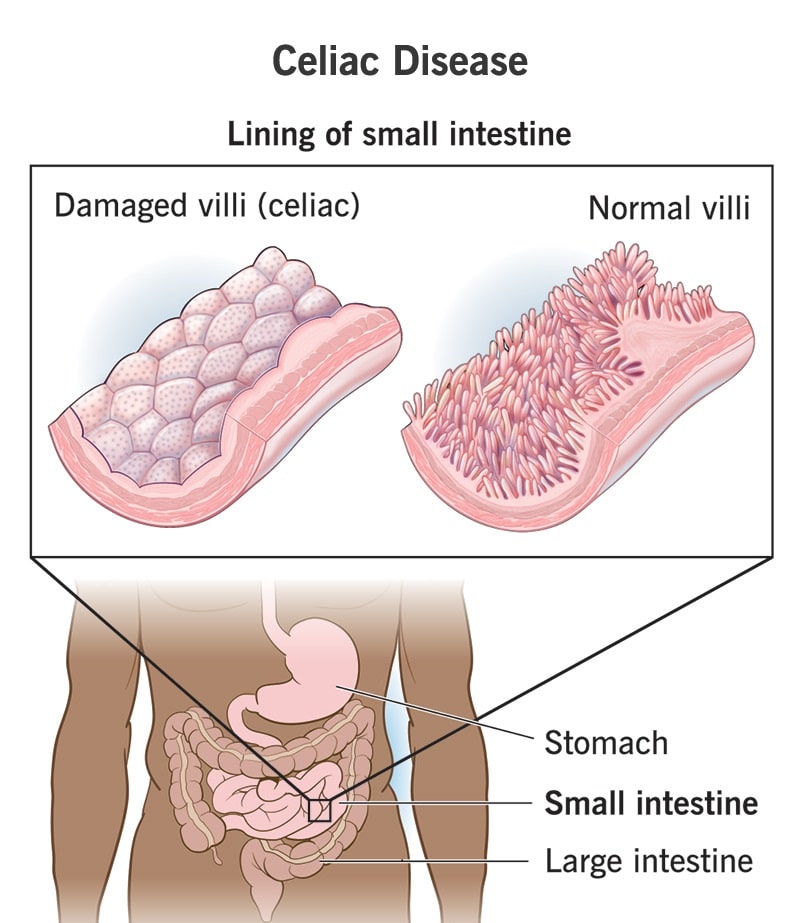Celiac Disease
Celiac disease is a serious autoimmune disease. It occurs in people with a genetic condition where gluten consumption causes damage to the small intestine. Celiac is estimated to affect 1 in 100 people worldwide, but only about 30 percent are diagnosed.
Celiac Disease Symptoms
The symptoms are not the same as food allergies. When accidentally ingesting food containing gluten, the person will experience intestinal problems such as diarrhea, excessive gas, and constipation. Other symptoms seen in sufferers include:
- Stomach ache.
- Nauseous.
- Anemia.
- Rash or dermatitis herpetiformis).
- Loss of bone density.
- Headache or general fatigue.
- Bone or joint pain.
- Mouth ulcers.
- Weight loss.
- Heartburn.
In children, they are at risk of experiencing intestinal problems than adults. Symptoms are characterized by:
- Nausea or vomiting.
- Bloating or swelling in the stomach.
- Diarrhea.
- Constipation.
- Too much fat in the stool (steatorrhea).
- Weight loss.
Risk Factors for Celiac Disease
Celiac is at high risk for the following groups:
- Having a family history of Celiac or dermatitis herpetiformis.
- Having type 1 diabetes.
- Having Down syndrome or Turner syndrome.
- Having autoimmune thyroid disease.
- Having Addison’s disease.
Causes of Celiac Disease
It is not yet known exactly what causes Celiac. This disease triggers a reaction from the immune system to gluten by damaging the small hair-like projections (villi) that line the small intestine. Damaged villi prevent the body from getting essential nutrients from food.
Celiac Disease Diagnosis
Celiac diagnosis is done with the following steps:
- Serology tests. These tests look for antibodies in the blood. Elevated levels of certain antibody proteins indicate an immune reaction to gluten.
- Genetic testing. Testing is done with human leukocyte antigens (HLA-DQ2 and HLA-DQ8) to rule out celiac disease.
If the test results indicate celiac disease, your doctor will likely do further testing by:
- Endoscopy. This procedure uses a long tube with a tiny camera on the end. The camera allows the doctor to see the small intestine and take a small tissue sample (biopsy) to analyze damage to the villi.
- Capsule endoscopy. This procedure uses a small wireless camera to take pictures of the entire small intestine. The camera is inside a vitamin capsule that is swallowed. As the capsule travels through the digestive tract, the camera takes pictures of the condition of the intestine.
Celiac Disease Treatment
Celiac treatment can be done with the following steps:
Gluten-Free Diet
These are the foods that sufferers need to avoid
- Wheat.
- Barley.
- Wheat.
- Potato flour.
- Malt.
- Semolina.
- Triticale.
- Bread.
- Pasta.
- Cereals.
- Spell.
Gluten can be hidden in foods, medicines, and non-food products, including:
- Modified food starch, preservatives, and food stabilizers.
- Prescription and over-the-counter medications.
- Vitamin and mineral supplements.
- Herbal and nutritional supplements.
- Lipstick products.
- Toothpaste and mouthwash.
- Envelopes and stamp glue.
- Play-doh.
Vitamin and Mineral Supplements
The use of supplements is done in patients with anemia or severe nutritional deficiencies. Supplements consumed include:
- Copper.
- Folate.
- Iron.
- Vitamin B-12.
- Vitamin D
- Vitamin K.
- Zinc.
Complications of Celiac Disease
Untreated Celiac Disease can cause:
- Malnutrition. This occurs when the small intestine cannot absorb enough nutrients from food. Malnutrition causes anemia and weight loss. In children, malnutrition causes growth retardation and short stature.
- Weakening of bones. Malabsorption of calcium and vitamin D causes softening of bones (osteomalacia or rickets) in children and loss of bone density (osteopenia or osteoporosis) in adults.
- Infertility and miscarriage. Malabsorption of calcium and vitamin D causes reproductive problems.
- Lactose intolerance. Damage to the small intestine causes abdominal pain and diarrhea after eating or drinking dairy products containing lactose.
- Cancer. People who do not maintain a gluten-free diet have a greater risk of developing several forms of cancer, including intestinal lymphoma and small bowel cancer.
- Nervous system problems. Some people experience seizures or nerve disease in the hands and feet (peripheral neuropathy).
Celiac Disease Prevention
Prevention is done by reducing the risk. These are the steps that can be taken:
- During pregnancy, stick to a gluten-free diet. Gluten consumption during pregnancy activates the disease and causes malabsorption of nutrients in both mother and fetus, increasing the risk of miscarriage.
- Genetic testing for babies. If the baby tests positive for Celiac, antibody blood tests should be done after the child is 3 years old and every two to three years thereafter.
- Breastfeeding for at least six months. Based on research, delayed symptoms among infants at risk of Celiac disease who are breastfed for at least 6 months, can occur.
- Introduce gluten slowly after the child is between 4 and 6 months old. Adding gluten to children while breastfeeding lowers the risk of Celiac disease after they are 2 years old.
- Mothers who breastfeed their children after adding gluten to their diet reduce the risk of their children developing Celiac disease later in life.

